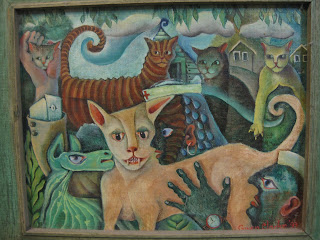I have been reading Robert Graves' 'Greek Myths' and am intrigued by the messages from the past which enable us to piece together the myths, legends and facts (we know there were lions in ancient Greece because of the ones painted on kraters and other clay pots) of previous peoples. The paintings on ancient pottery are a considerable source of this information, so I decided to make a sort of 'rosetta stone' of my own.
What would someone from the future make of this?
 |
| press the selected items into the clay |
 |
| close up of the mysterious message ;-) |
 |
| the pour.....tension mounts, how will it turn out???? |
 Leave the plaster to harden for about an hour, peel away the clay. |
| I trimmed the edges with a stanley knife, as had been demonstrated by Paul, and Ta da!! The 'Delves Stone' |
It is not difficult to see the influence of these images in my plaster cast above.
















